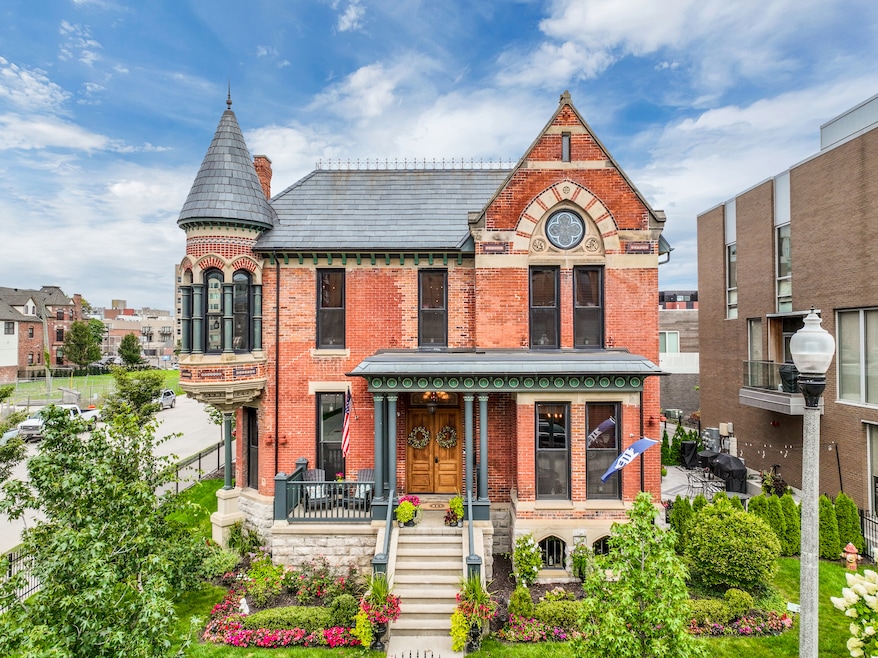For decades, an 1867 Venetian Gothic home outside downtown Detroit was vacant and crumbling. The entire roofline had collapsed and its characterizing turret had fallen. The home, a masterpiece of the time, was left a near pile of bricks.
The dilapidated home on the appropriately named Alfred Street served as a backdrop in the 2016 movie "Batman v. Superman: Dawn of Justice," and its restoration became the focus of an eight-part series on HGTV’s “Rehab Addict." Now, one of the two units is listed at $2.1 million.
The mansion is known as the Ransom Gillis House for its original owner, a merchant who sold the home shortly after it was built, according to Historic Detroit. Architect Henry T. Brush designed the home and went on to create several more elaborate mansions throughout the city, many of which did not have the fortunate future of the Gillis House.
The Gillis House became one of many mansions built in the Detroit neighborhood of Brush Park, so much so that the area was deemed “Little Paris” in the late 1800s. Several homes remain, sporadically placed among new modern construction that fills the lots where other mansions once stood.

“This neighborhood were all historic mansions that spanned across five to six blocks. Over time, as Detroit went through eras of riots and distress, these structures and homes were abandoned. Some were burned down, some were left to deteriorate,” said listing agent Erica Collica of Max Broock Realtors.
This home was one of them until 2015, when “Rehab Addict” host Nicole Curtis picked up the project and rebuilt it with historically appropriate features and split it into a duplex. The for-sale unit is the front of the home, spanning 2,815 square feet with three bedrooms and four bathrooms, along with a side patio and finished garden level.
'Mothballing' helped save the turret
The city rebuilt the turret and roof in 2005 in an effort to preserve the home until it could be restored and renovated, what it calls “mothballing.” Before that, the home was just the perimeter walls. Curtis and the development team rebuilt it to match the original home. The project included commissioning custom-stained-glass windows and fireplaces to match what would have been in the home.
“In the kitchen, those cabinets were made to be reminiscent of that time period, so they're custom, really high-quality cabinets, but it feels like 1876,” said Collica. “That’s what I see a lot of developers doing wrong; they put the latest and greatest, trendy into these houses, and it doesn’t do justice.”
Even the mortar used to rebuild portions of the home was a mix customized for historic bricks, and a monogrammed stained-glass window above the front door includes Ransom Gillis’ initials.

Collica’s favorite part of the home is the embedded tile in the entry with “Ransom Gillis House” stamped and imagery of the home’s notable turret. The tiles were created by one of the oldest operating potteries, Pewabic Pottery, which started in the home’s now-demolished carriage house in 1903.
The current seller finished the basement and added a bathroom and a patio, creating a home that could welcome dozens at a time.
“He’s welcomed upwards of 50 people in the front yard and been able to come in and go out, go in the garden level and upstairs,” said Collica. “It’s the kind of place where you say, ‘Oh, I’m going to the Ransom Gillis House for dinner,’ and you go home and tell all your friends. It’s pretty remarkable. It’s almost like a museum.”
Renovation that kick-started the trendy neighborhood
The renovation in 2015 came before downtown Detroit’s recent redevelopment, noted Collica, which added attention to the home, located a mile outside downtown.

“You’d drive through, and it looked like a war zone almost with empty fields and not a lot going on, so to have a renovation to this extent in this neighborhood was interesting to a lot of people,” she said. “Now that neighborhood is filled with million, $2 million homes all day long.”
About 2,000 people lined up to tour the home after its completion, according to media reports. Collica now describes the neighborhood of Brush Park as where the “who’s who” of Detroit lives. The Gillis House renovation became the first development move from developer Bedrock in the Brush Park neighborhood.
According to Homes.com data, the average price of a home in Brush Park is $617,356 with an average price per square foot of $355. Ten other historic mansions in the neighborhood sold within the past year, with the priciest at $1.05 million for a 2,725-square-foot duplex unit down the street from 205 Alfred St. Another four-bedroom, four-bathroom home on the same street sold for $945,000 in July. The priciest home for sale is within a newly constructed condominium building, listed for $2.32 million.
